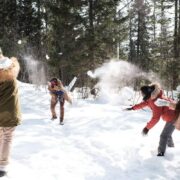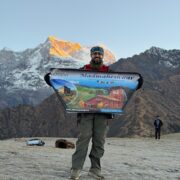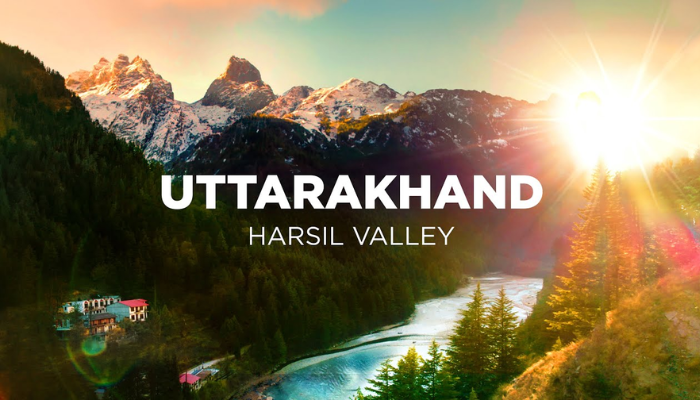
Welcome to Monsoon Magic: Harsil Valley at Its Lushest
Harsil Valley Tour Package : Stepping into Harsil Valley during the monsoon is like entering a scene from a dream, where nature paints with the most vibrant shades of green. Nestled deep in the Garhwal Himalayas, this hidden gem transforms into an ethereal paradise, unlike anything you’ve seen before. If you’ve been considering “Chopta tour packages,” you might find Harsil Valley to be the serene, untouched counterpoint you didn’t even know you were looking for.
I remember my first monsoon visit. The journey itself was an experience – misty roads weaving through dense forests, the air cool and crisp, carrying the earthy scent of rain. As we descended into the valley, a blanket of soft fog seemed to lift, revealing an explosion of green. The Bhagirathi River, swollen with rainwater, roared a magnificent symphony as it carved its path through the valley. It wasn’t just beautiful; it was incredibly peaceful, a quiet embrace from nature.
The real magic of Harsil Valley in monsoon lies in its peaceful atmosphere. Unlike more bustling hill stations, Harsil remains relatively tranquil, making it perfect for those seeking solitude and a deep connection with nature. The majestic pine forests, already impressive, become incredibly mystical when shrouded in mist. Every tree drips with moisture, the ground beneath is carpeted in damp moss, and the distant peaks play hide-and-seek with the clouds. It’s a landscape that encourages quiet contemplation, gentle strolls, and simply breathing in the pure, unadulterated mountain air.
While many travelers flock to popular destinations, Harsil offers an authentic Himalayan experience that feels undiscovered. For those who enjoy adventure and natural beauty but prefer a less commercialized setting than some of the more frequented spots, adding Harsil to your itinerary is a must. It’s becoming increasingly common for people planning “Chopta tour packages” to extend their journey slightly to explore this tranquil valley, appreciating its unique monsoon charm before or after their high-altitude treks. The vivid greenery, the soft mist, and the powerful river all combine to make a “Harsil Valley tour package” in monsoon an unforgettable journey into nature’s lushest embrace.
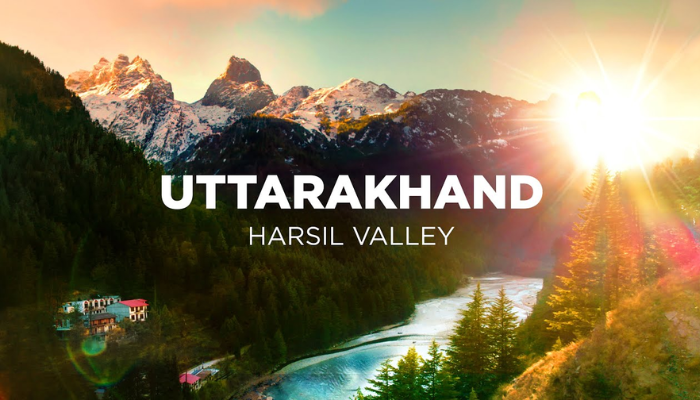
Itinerary For Harsil Tour Package
DAY 0: Departure from delhi
- Depart from botanical garden Metro Station at 10:00pm.
- Begin your overnight journey towards Harsil.
DAY 1: Visit Uttrarkashi and Harsil
- Reach uttarkashi by morning, freshen up & Have Breakfast and Resume your Journey to harsil.
- Reach harsil in evening check in at your accomodation.
- Enjoy bonfire session in the evening.
- Overnight stay in harsil.
DAY 2: Gartang Gali & Lama Top
- Early morning breakfast.
- Depart for:
- Gartang Gali (Approx. 25km from Harsil ) – thrilling wooden cliff-side walkway offering breathtaking views of the Jadh Ganga gorge (permit may be required ).
- After Gartang Gali, head toward Lama Top – a short trek offering panormic views of the Himalayan ranges.
- Return to Harsil by evening.
- Dinner and overnight stay in Harsil.
DAY 3: Harsil To Delhi
- Morning: Check out and begin the journey back to delhi.
- Evening : Arrive at Delhi , concluding the tour
Why Harsil Valley is the Hidden Monsoon Gem of Uttarakhand
Harsil Valley, tucked away in the serene Garhwal Himalayas, emerges as a truly hidden gem of Uttarakhand, particularly during the monsoon season. While many flock to popular destinations like Chopta, Harsil offers an unparalleled tranquil experience, making the monsoon an ideal and unique time to visit.
The Monsoon’s Embrace: An Ideal Time
For those who appreciate nature’s raw, untamed beauty, the monsoon (July to September) transforms Harsil into a vibrant spectacle. Unlike the dry, sometimes dusty landscapes of summer or the stark, snow-laden vistas of winter, the rainy season breathes life into every corner. The air is exceptionally clean and crisp, carrying the sweet scent of moist pine and deodar forests. The average temperature during these months ranges from a comfortable 15°C to 22°C during the day, making it pleasant for leisurely walks and simply soaking in the atmosphere.
Compared to other seasons, monsoon reveals a different side of Harsil. While spring (March to May) brings blooming apple blossoms and autumn (September to November) offers clear skies and golden foliage, the monsoon offers an immersive, lush green experience that feels deeply rejuvenating.
Minimal Crowds, Maximum Serenity
One of Harsil’s biggest draws, especially during the monsoon, is its relatively untouched nature. Unlike more commercialized hill stations such as Shimla, Mussoorie, or even parts of Chopta, Harsil maintains a peaceful ambiance. There are no overwhelming crowds, blaring music, or endless rows of shops. This minimal commercialization allows you to truly connect with the pristine environment and the local culture. For those seeking quiet contemplation, genuine peace, and a break from urban chaos, Harsil offers that rare sense of undisturbed serenity. The fewer tourists mean more intimate moments with nature.
Fresh River Streams and Lush Apple Orchards
The Bhagirathi River, which gracefully flows through the valley, comes alive during the monsoon. Its crystal-clear waters, fed by the rains, swell and rush with an invigorating energy, creating a soothing natural soundtrack to your stay. You can spend hours by its banks, feeling the fresh spray and watching the powerful current.
Harsil is famously known as the “Apple Valley,” and its vast apple orchards turn a brilliant, vibrant green during the monsoon. While the apple harvest typically happens in autumn, the monsoon months showcase the trees at their lushest, laden with developing fruit. Walking through these orchards feels incredibly refreshing, surrounded by dense foliage and the promise of a bountiful harvest. This unique combination of fresh river streams and verdant orchards, set against a backdrop of mist-shrouded peaks, makes Harsil an unparalleled Harsil Valley travel guide recommendation for the monsoon. Many Harsil Valley tour packages from Delhi specifically highlight these natural attractions, ensuring you experience the very best of this hidden gem.
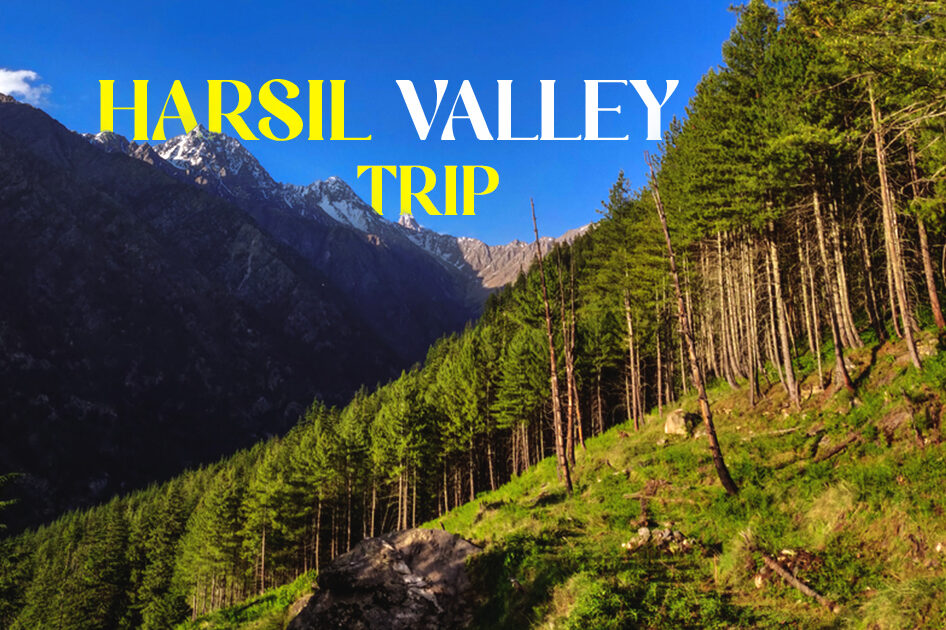
How to Reach Harsil Valley During Monsoon
Reaching Harsil Valley during the monsoon is an adventure in itself, as the journey transforms with the weather, offering incredible views along the way. While accessible, it requires a bit more planning and caution due to the rainy season’s specific conditions.
From Delhi: The Road Trip Experience
The most common and flexible way to reach Harsil Valley from Delhi is by road. The distance is approximately 450-470 kilometers, and the journey typically takes around 12-14 hours. The usual route goes via Meerut, Muzaffarnagar, Haridwar, Rishikesh, Chamba, Dharasu, Uttarkashi, and then on to Harsil.
Road Conditions in Monsoon: The initial stretches from Delhi to Rishikesh are generally well-maintained highways. However, once you enter the mountainous terrain beyond Rishikesh and especially after Uttarkashi, the road conditions can change. Expect winding roads, which might be wet and slippery. There can be occasional small landslides or slushy patches, particularly between Uttarkashi and Harsil (near Bhatwari and Sukhi Top), and you might encounter small water crossings. Visibility can also be reduced due to fog or heavy rain.
Tips for a Delhi to Harsil Valley road trip:
- Start Early: Begin your journey from Delhi in the very early hours of the morning to avoid city traffic and cover a good portion of the plains before daylight.
- Drive Cautiously: Maintain a moderate speed, especially in the hills. Avoid sudden braking and allow extra time for your journey.
- Check Updates: Stay updated on road conditions before and during your travel. Local authorities or online travel forums can provide real-time information.
- Overnight Stop (Optional but Recommended): For a more relaxed journey, consider an overnight stop in Rishikesh or Uttarkashi. This breaks up the long drive and allows you to tackle the mountain section refreshed.
Connecting by Train (and then Road)
While Harsil Valley does not have its own railway station, you can combine a train journey with a road trip.
- Nearest Railway Stations: The closest major railheads are Rishikesh (around 215 km) and Dehradun (around 230 km).
- Train from Delhi: You can take a train from Delhi to either Rishikesh or Dehradun. Popular trains include the Shatabdi Express (to Dehradun) for a fast, comfortable ride, or overnight trains like the Mussoorie Express.
- Road from Rishikesh/Dehradun: From Rishikesh or Dehradun, you’ll need to hire a private taxi or take a shared jeep/bus towards Uttarkashi. From Uttarkashi, local transport is available for the final leg to Harsil. The road journey from Rishikesh or Dehradun to Harsil can take approximately 8-9 hours in monsoon conditions.
From Uttarkashi to Harsil Valley Route
Uttarkashi serves as a major hub before reaching Harsil. The distance from Uttarkashi to Harsil is about 72 kilometers, typically taking 2.5-3 hours in normal conditions. During monsoon, this segment might take longer due to occasional road challenges. This part of the journey is particularly scenic, with the Bhagirathi River accompanying you for much of the way.
Combining with Chopta Tour Packages
Many travelers who are exploring “Chopta tour packages” often extend their road trip to include Harsil Valley. This allows them to experience two distinct, yet equally breathtaking, facets of Uttarakhand’s natural beauty – the high-altitude meadows and spiritual trails of Chopta, and the serene, lush valley of Harsil. While the direct route between Chopta and Harsil requires traversing significant mountain roads, it’s a popular combination for those undertaking an extended Garhwal road trip. Such comprehensive “Harsil Valley tour packages from Delhi” are available, offering a well-planned itinerary for covering multiple destinations.
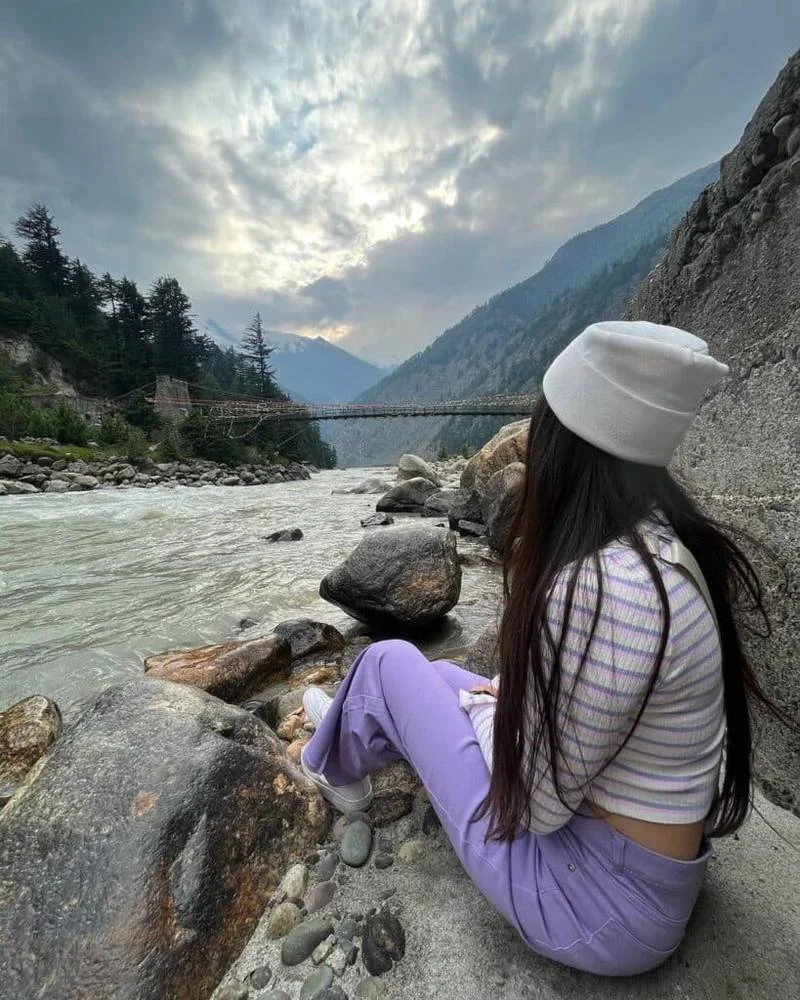
Must-Visit Places Around Harsil in the Rainy Season
Harsil Valley’s true charm amplifies during the monsoon, as the surrounding landscapes burst with life. While the major pilgrimage season for Gangotri winds down, the region around Harsil offers an incredibly serene and beautiful experience, often less crowded, making it a highlight of any “Harsil Valley travel guide” for the rainy months.This detailed Harsil Valley travel guide covers routes, stays, and must-visit places.
Mukhwa Village: The Winter Abode of Goddess Ganga
Just a short distance (around 3-4 km) from Harsil, Mukhwa Village is a significant spiritual and cultural stop. It serves as the winter abode for the idol of Goddess Ganga when the Gangotri Temple closes due to heavy snowfall. In monsoon, the quaint village, with its traditional wooden houses, becomes even more picturesque amidst the fresh greenery. The air feels pure and spiritually charged.
Monsoon Beauty Tip: Take a leisurely walk through the village lanes. The rustic architecture, combined with the surrounding misty deodar forests and the sound of distant streams, offers fantastic opportunities for photography and a truly immersive cultural experience.

Dharali: Apple Orchards and Ancient Lore
Located about 2 kilometers from Harsil, Dharali is another charming village renowned for its vast apple orchards. During the monsoon, these orchards are exceptionally lush and vibrant, laden with developing green apples. Dharali also holds ancient significance, with the Kalp Kedar Temple, submerged in the Khera Gad stream, believed to be 5,000 years old.
Monsoon Beauty Tip: Stroll through the apple orchards after a light rain. The glistening leaves and the cool, fresh air create a refreshing ambiance. The sight of the burgeoning apples, even though not yet ripe for harvest, is a testament to the valley’s fertility.
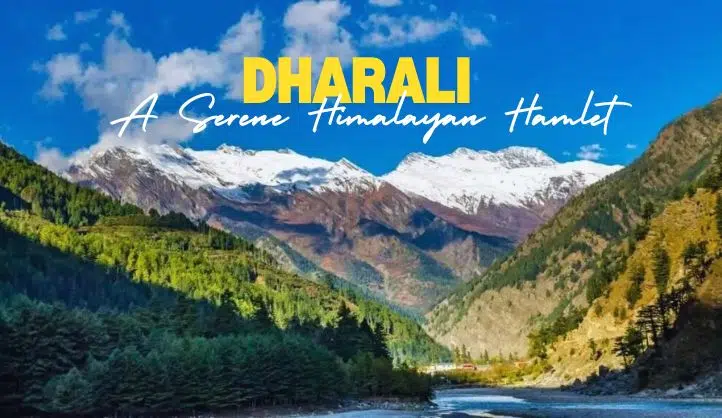
Bhagirathi River Banks: Nature’s Symphony
The majestic Bhagirathi River, one of the primary headstreams of the Ganges, flows right through Harsil Valley. In the monsoon, the river swells, its waters rushing with an impressive force. The sound of the gushing river becomes a constant, soothing backdrop to your stay.
Monsoon Beauty Tip: Find a quiet spot along the river banks. The view of the powerful, clear river set against the backdrop of emerald hills, often partially obscured by drifting clouds, is truly mesmerizing. It’s an ideal place for quiet contemplation, photography, or simply enjoying the raw power of nature. Be mindful of rising water levels during heavy rainfall.
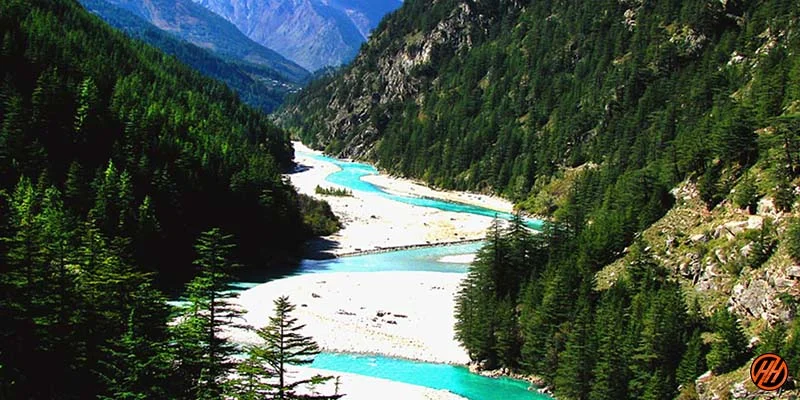
Wilson Cottage: A Glimpse into History
Nestled amidst the deodar forests in Harsil village itself, Wilson Cottage carries a fascinating history. Built by Frederick “Pahadi” Wilson, a British deserter who settled here in the mid-19th century and introduced apple cultivation to the valley, this double-storied wooden house offers a peek into a bygone era.
Monsoon Beauty Tip: The dense deodar forests surrounding the cottage appear even more mystical and enchanting in the monsoon mist. The historical tales associated with Wilson and his local Garhwali wife, Gulabi, resonate more deeply in the quiet, atmospheric surroundings. It’s a great spot for an easy walk and some historical imagination.
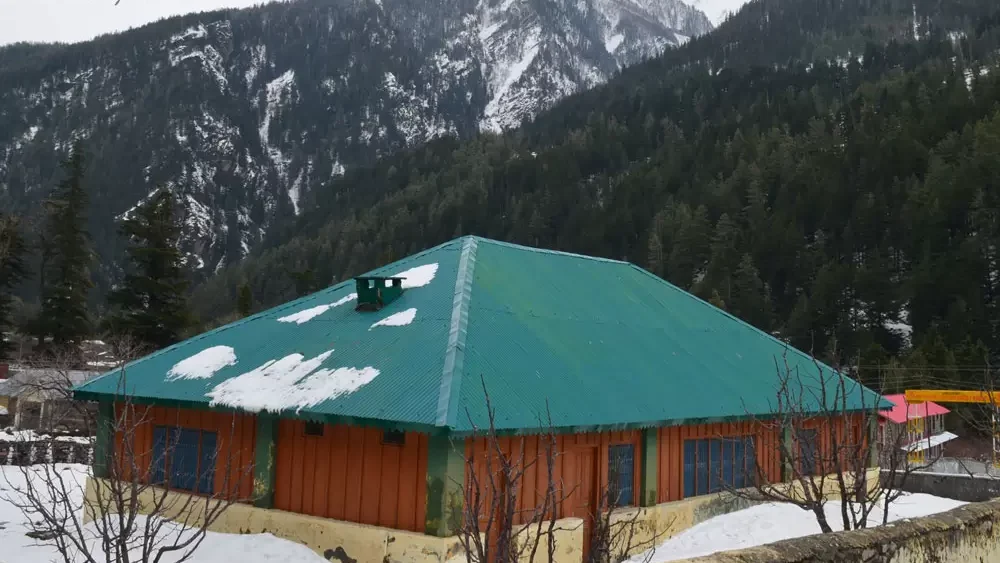
Gangotri: The Source of Purity (with considerations)
While technically a bit further (around 25 km from Harsil), Gangotri is a pilgrimage site of immense spiritual significance and is often part of “Gangotri tour packages from Delhi” that include Harsil. It is the revered source of the Bhagirathi River.
Monsoon Beauty Tip: The journey from Harsil to Gangotri is incredibly scenic, passing through dense forests and alongside the roaring river. In monsoon, the landscape leading up to Gangotri is intensely green. However, it’s crucial to exercise caution as the road can be prone to landslides and heavy rainfall can make travel difficult. The Gangotri Temple itself might experience fewer crowds, offering a more peaceful darshan. Always check local weather and road advisories if you plan Harsil to Gangotri travel plan during heavy monsoon. While the temple remains open, the surrounding trek to Gaumukh is often not advised due to slippery and challenging conditions.
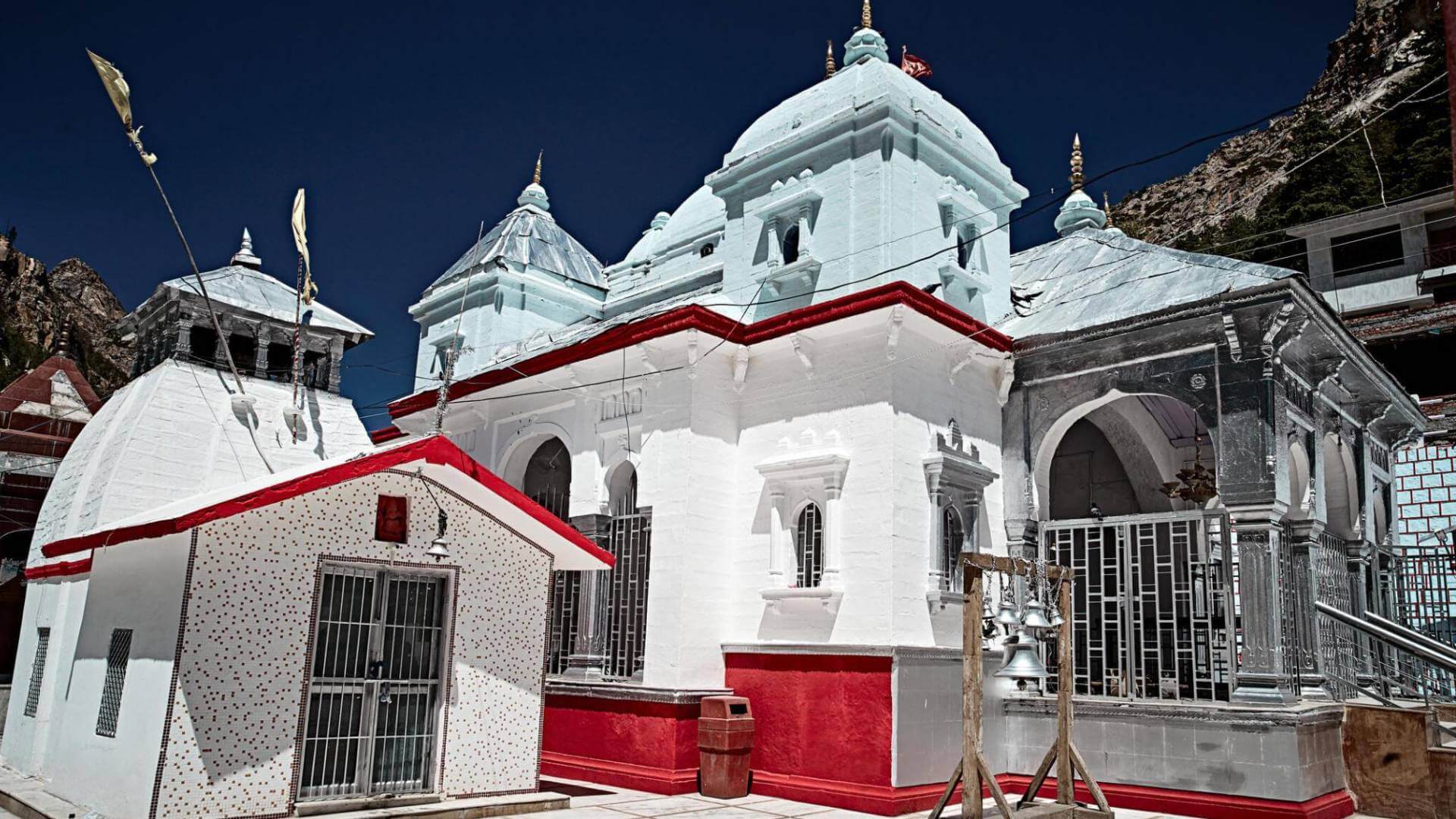
Gartang Gali Trek: A Monsoon Adventure from Harsil
The Gartang Gali trek, a marvel of ancient engineering, offers a truly unique adventure that blends history with breathtaking natural beauty. While popular during clearer seasons, attempting the “Gartang Gali trek from Harsil” during the monsoon presents a distinct and memorable experience, though it requires careful consideration for safety.
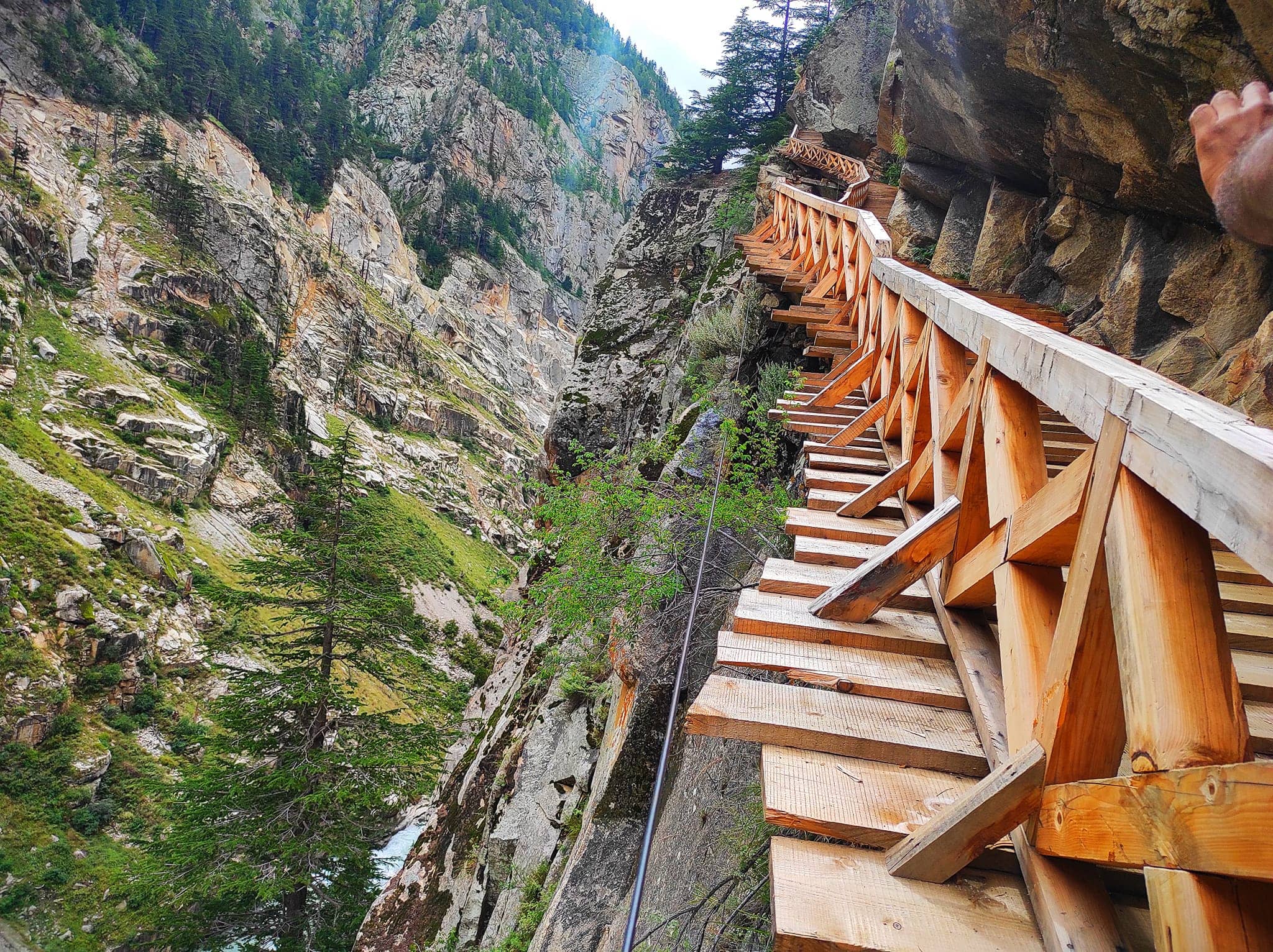
Trek Details: Difficulty and Safety in Monsoon
- Location and History: Gartang Gali is a historic wooden skywalk, approximately 136 meters long and 1.8 meters wide, ingeniously carved into a sheer rock face. Located near Bhaironghati, about 25 km from Harsil (on the way to Gangotri), it was part of an ancient Indo-Tibetan trade route used by Pathan traders over 150 years ago. It was reopened to tourists in 2021 after extensive restoration.
- Difficulty: The trek to Gartang Gali is generally considered easy to moderate. From Lanka Bridge (the starting point after a short drive from Harsil), it’s a walk of about 2.5 kilometers (one way) through a beautiful coniferous forest. While the path itself is well-maintained with wooden planks and railings, there are some steep sections and steps.
- Safety in Monsoon: This is the most critical aspect. While the landscape around Gartang Gali is incredibly lush and vibrant during the monsoon, heavy rainfall can make the trail slippery. There’s also an increased risk of small landslides or rockfalls, particularly on the approach roads to Bhaironghati.
- Recommendation: While some sources suggest avoiding July and August for trekking due to potential landslides and slippery paths, if you do decide to go, it’s paramount to exercise extreme caution.
- Essential Precautions: Always check the local weather forecast and road conditions before heading out. It is highly recommended to go with a local guide who is familiar with the monsoon conditions of the trail. Wear sturdy, waterproof trekking shoes with excellent grip, and carry rain gear. Avoid venturing out during heavy downpours or immediately after. Local authorities may also close the trek on days of severe weather for safety.
Scenic Views and Historical Resonance
The views from Gartang Gali are nothing short of spectacular. As you walk along the cliff-hugging wooden structure, you’ll be treated to panoramic vistas of the deep Nelong Valley below and the majestic Jadh Ganga River rushing far beneath you. The surrounding mountains, cloaked in monsoon’s emerald green and often partially veiled in mist, create an ethereal atmosphere. Beyond the natural beauty, the trek offers a profound sense of history, allowing you to walk in the footsteps of ancient traders who once braved this perilous path.
Planning the Trek and Blending with Itinerary
- Starting Point: The trek begins from Lanka Bridge, which is easily accessible by a short drive (approx. 16 km) from Harsil.
- Time Required: The round trip to Gartang Gali from Lanka Bridge typically takes about 3-4 hours, depending on your pace and time spent admiring the views.
- Permits: Since Gartang Gali falls within Gangotri National Park and is close to the Indo-Tibetan border, you’ll need a permit from the forest department. It’s advisable to arrange this in advance or confirm with your “Harsil Valley tour package” operator that it’s included.
- Integration with Harsil-Gangotri Itinerary: The Gartang Gali trek blends perfectly with a “Harsil Gangotri Gartang Gali itinerary.” It’s located en route to Gangotri, making it a natural stop. Many travelers visit Gartang Gali in the morning and then proceed to Gangotri, allowing for a day that combines adventure with spiritual solace. Reputable “Gangotri tour packages from Delhi” often include this thrilling historical trek, offering a comprehensive experience of the region’s diverse attractions.
What to Pack and Prepare for a Rainy Season Harsil Trip
A trip to Harsil Valley during the monsoon is an incredible experience, but thoughtful packing and preparation are crucial for a safe and comfortable “Harsil Valley monsoon travel.” The weather can be unpredictable, with sunny spells giving way to sudden downpours and mist, so being ready for anything is key.
Essential Packing List: Stay Dry and Warm
- Rain-Proof Jackets: A high-quality, breathable, and waterproof rain jacket or shell is non-negotiable. Look for one that offers good coverage and protection from wind. A waterproof poncho can also be a handy backup.
- Waterproof Shoes: This is perhaps the most important item. Invest in sturdy, waterproof trekking shoes with excellent grip. Trails can become incredibly slippery and muddy. Consider carrying an extra pair of quick-drying sandals or floaters for use around your accommodation.
- Warm Layers: Even though it’s monsoon, Harsil’s altitude means temperatures can drop, especially in the evenings or after rain. Pack fleece jackets, woolen sweaters, and thermal inners. Quick-drying synthetic fabrics are better than cotton for base layers, as they won’t stay damp.
- Socks: Carry multiple pairs of woolen or synthetic socks to keep your feet warm and dry. Wet feet are uncomfortable and can lead to blisters.
- Headlamp/Flashlight: Power cuts can occur during heavy rains in the hills, so a reliable headlamp or flashlight with extra batteries is essential.
- Power Banks: Network and electricity can be intermittent. A fully charged power bank will ensure your phone and other devices stay powered for communication and photography.
- Photography Gear Protection: If you’re carrying a camera, invest in a waterproof camera bag or rain covers. Ziplock bags are great for protecting smaller electronics like phones and spare batteries.
- Basic Toiletries and First-Aid: Include a quick-dry towel, mosquito repellent, hand sanitizer, and a basic first-aid kit with medications for cold, fever, pain, and stomach upset.
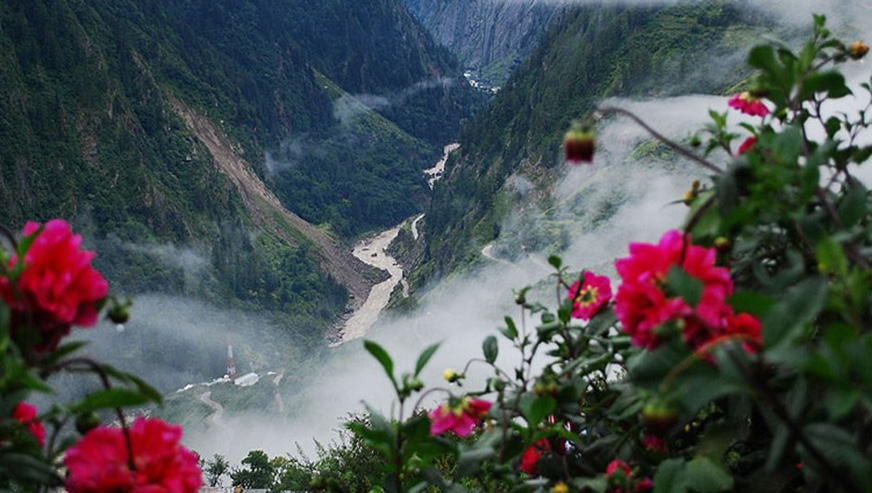
Driving in the Hills During Rain: Exercise Caution
If you’re undertaking a “Harsil Valley tour packages from Delhi” by car, extra vigilance is needed.
- Reduced Speed: Always drive slowly. Wet roads, limited visibility due to fog or heavy rain, and the possibility of unexpected obstacles demand a cautious approach.
- Headlights and Fog Lamps: Keep your headlights on even during the day to enhance visibility for yourself and other drivers. Use fog lamps in misty conditions.
- Maintain Distance: Increase the distance from the vehicle in front of you. Braking distances are longer on wet roads.
- Road Conditions: Be aware that small landslides, falling rocks, or slushy patches can occur. Drive around them carefully. Avoid stopping directly below precarious slopes.
- Tyres and Wipers: Ensure your vehicle’s tires have good tread depth and your wiper blades are in excellent condition for clear visibility.
Monsoon-Specific Safety Advice: Prioritize Well-being
- Check Forecasts: Continuously monitor weather forecasts before and during your trip. Be prepared for last-minute changes to your itinerary due to heavy rain or road closures.
- Stay Hydrated and Eat Well: Drink plenty of boiled or bottled water to avoid waterborne illnesses. Stick to freshly cooked food from hygienic sources.
- Local Guidance: Always consult with locals or your accommodation staff about safe areas for walking or trekking, especially if you plan to explore off the main routes. They will have the most current information on local conditions.
- Avoid Risky Areas: Steer clear of riverbanks during heavy rain, as water levels can rise rapidly. Do not attempt to cross swollen streams.
By adhering to these practical tips, your “Harsil Valley travel guide” for the monsoon will lead you to a memorable and safe adventure in this hidden gem.
Where to Stay in Harsil During the Monsoon
Finding the right place to stay can make your monsoon trip to Harsil Valley even more magical. As the mist rolls over the mountains and raindrops tap gently on rooftops, staying at a warm and welcoming place enhances the entire experience. Whether you’re looking for peace, comfort, or views, Harsil has a mix of cozy homestays, scenic riverside cottages, and budget hotels that cater to every traveler’s need.
Harsil homestays are among the best ways to experience local hospitality. Run by friendly mountain families, these stays offer home-cooked Garhwali meals, stories from the region, and a chance to live close to nature. Most of these are simple yet clean, with basic amenities and unbeatable views of the Bhagirathi River and lush green hills.
If you’re planning your Harsil Valley tour packages from Delhi, many agencies include stays in riverside lodges or eco-resorts that give you easy access to nearby attractions like Mukhwa Village, Dharali, and the path to Gangotri. Some of these properties even organize short hikes and village walks for their guests during breaks in the rain.
For those on a tighter budget, there are also a few small hotels and guesthouses near the Harsil market area. They provide essential amenities like hot water, simple food, and clean rooms — perfect for trekkers or solo travelers.
Several new eco-stays have also come up in recent years. These are built using sustainable materials and managed by locals who are deeply connected to the land. They blend beautifully into the environment and are perfect for travelers who want a quiet and meaningful stay amidst the mountains.
No matter where you choose to stay, waking up in Harsil during the monsoon is an unforgettable experience. The fog, the sound of flowing rivers, and the aroma of rain-washed pine trees make it feel like a Himalayan dream.
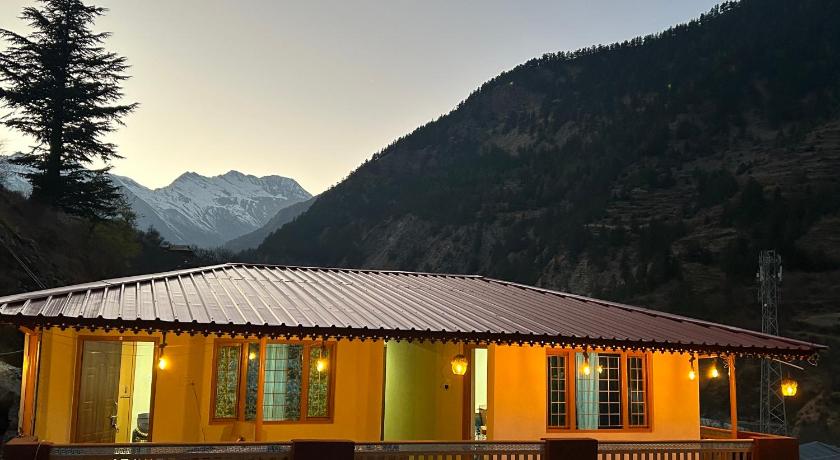
Local Culture and Spiritual Touch of Harsil Valley
Harsil Valley is not just about landscapes and trekking trails — it’s also a beautiful blend of spirituality and local culture that quietly seeps into your soul as you explore its serene surroundings. Especially during the monsoon, when nature feels raw and alive, the spiritual vibe of the valley becomes even more pronounced.
Nestled on the banks of the Bhagirathi River, Harsil is a small but culturally rich hamlet in Uttarkashi district. Life here is simple and deeply connected to nature. The locals — mostly from the Bhotiya community — follow age-old customs and traditions, many of which are rooted in Hindu mythology and regional folklore. Their warm hospitality, traditional homes, and slow-paced lifestyle make you feel grounded and welcome.
A spiritual highlight near Harsil is Mukhwa Village, which serves as the winter home for the idol of Goddess Ganga when the Gangotri temple shuts during the colder months. Even during the monsoon, this quaint village is a quiet place to connect with the spiritual energy of the region. It’s also a great spot to witness traditional architecture and interact with locals.
For travelers coming on Gangotri tour packages from Delhi, a stop at Harsil offers a refreshing spiritual pause before continuing to the temple. Surya Kund and other sacred spots near Gangotri are not too far from here and can be visited in a day trip.
In addition to its spiritual side, Harsil is known for its apple orchards, especially in villages like Dharali. During the rainy season, the orchards are lush and green, and while apples aren’t ripe yet, the views are postcard-perfect. Many families also sell locally made jams, pickles, and herbs — a perfect cultural souvenir.
Whether you’re a seeker, a nature lover, or someone just looking to slow down, the cultural and spiritual essence of Harsil adds depth to your journey — turning it into something more than just a vacation.
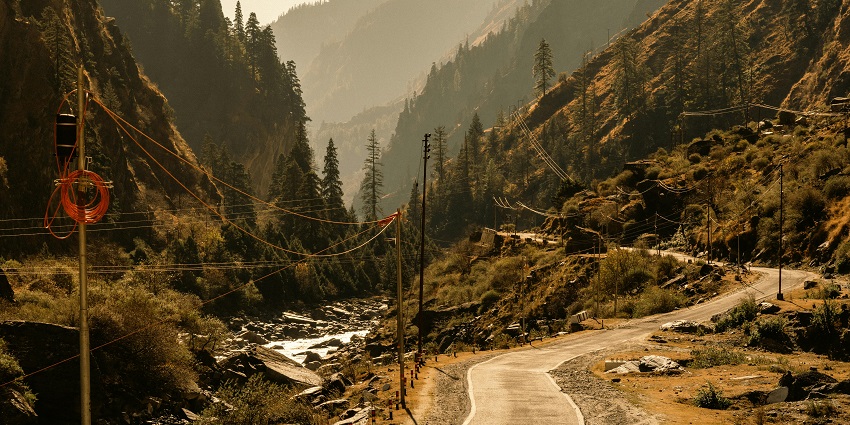
Faqs About Harsil Valley
1. Where is Harsil Valley located?
Harsil Valley is a scenic village in Uttarkashi district, Uttarakhand, situated on the banks of the Bhagirathi River, close to Gangotri Dham.
2. Is Harsil Valley safe to visit during the monsoon?
Yes, it is generally safe, but travelers should be cautious of occasional landslides and slippery mountain roads. It’s advised to check weather updates before a trip.
3. What is the best way to reach Harsil Valley from Delhi?
The most convenient route is by road. A Delhi to Harsil Valley road trip offers stunning views and flexible travel. You can also reach via Dehradun or Rishikesh by car or bus.
4. How far is Harsil from Delhi?
Harsil is approximately 460 km from Delhi, and it takes around 11–13 hours by road depending on stops and weather.
5. Are there any Harsil Valley tour packages from Delhi?
Yes, several travel operators offer Harsil Valley tour packages from Delhi, which include transport, accommodation, meals, and guided sightseeing.
6. What are the top places to visit in Harsil Valley during monsoon?
Top attractions include Bhagirathi River, Mukhwa Village, Dharali, Wilson Cottage, and Gangotri. Nearby, you can also explore Gartang Gali trek from Harsil.
7. What is the Gartang Gali trek itinerary like?
The Gartang Gali trek itinerary usually includes a short 1.5 km walk along a restored British-era wooden bridge trail, offering thrilling views of the gorge.
8. How far is Gangotri from Harsil?
Gangotri is about 25 km from Harsil and takes around 1 hour by road. Many Gangotri tour packages from Delhi include Harsil as a stopover.
9. What is the best time to visit Harsil Valley?
While Harsil is beautiful year-round, the best time to visit Harsil Valley is from April to June and September to early November. Monsoon (July–August) is lush and quiet but comes with rain risks.
10. Can I visit Harsil and Chopta together in one trip?
Yes, you can combine both in a single tour. Many travelers pair Harsil Valley tour packages with Chopta tour packages for a diverse Uttarakhand experience.
11. What is the spiritual significance of Harsil?
Harsil is spiritually important due to its proximity to Gangotri Temple. Mukhwa Village is the winter seat of the idol of Goddess Ganga.
12. Are there budget accommodations in Harsil?
Yes, Harsil has a range of riverside cottages, homestays, and guesthouses. Many Harsil homestays are budget-friendly and offer warm hospitality.
13. Is the Uttarkashi to Harsil Valley route safe during monsoon?
Yes, but it’s advised to travel during daylight hours and check local updates due to landslide-prone areas in heavy rains.
14. What kind of food is available in Harsil?
Simple North Indian meals are commonly available. In homestays, you may also get to taste traditional Garhwali cuisine.
15. Are there ATMs in Harsil?
There are very limited ATM facilities, and they may not always function. It’s best to carry enough cash for your trip.
16. Is mobile network available in Harsil Valley?
BSNL and Jio offer the most reliable network. Internet connectivity is limited but sufficient for basic use.
17. Can solo travelers visit Harsil safely?
Yes, solo travel is safe in Harsil. Many solo trekkers explore the area, especially during the Gartang Gali trek or on the way to Gangotri.
18. How many days are enough for Harsil?
A 2- to 3-day stay is ideal. You can include nearby excursions to Gangotri and Gartang Gali in this time.
19. Do I need permits to visit Harsil or Gangotri?
No permits are needed for Indian nationals. Foreign tourists may need to register at checkpoints when going beyond Gangotri.
20. Can I book customized Harsil Gangotri Gartang Gali itinerary?
Yes, many agencies offer customizable Harsil Gangotri Gartang Gali itineraries, allowing you to tailor the trip to your pace and preferences.
Recent Posts
Chakrata in Winters
Madmaheshwar Trek Difficulty & Beginner’s Complete Guide
Chopta in Winters
Tags

Thailand


